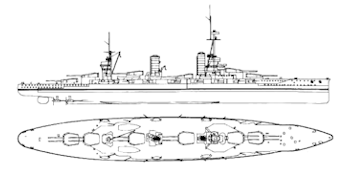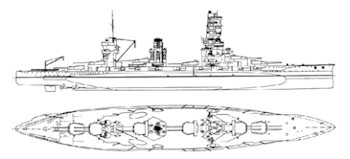




The provision of British naval technology in the early part of the century enabled the Japanese to built their first capital ship class without foreign assistance, the Fuso-class battleships. These were designed to complement the earlier Kongo-class battlecruisers and to provide a powerful counter to the US and British ships then under construction. With a main armament of twelve 14-in guns, it outgunned its US contemporaries (such as the New York-class) but was also faster at over 24 knots and had slightly better armor. Armament was arranged unconventionally, with two twin turrets at each end and two further turrets amidships. Unlike the main turrets, these were not superfiring, and resulted in a lengthened hull that reduced overall armor protection. Secondary armament consisted of 6-in guns arranged in casemates, as well as 3-in anti-aircraft guns that were later replaced by 5-in dual-purpose guns. Armor protection was adequate for its time but was to be upgraded later in their service life with a thicker deck and bulkheads for added underwater protection. A pagoda-style mast and more modern boilers (Kampon oil-fired) were also installed but the latter gave a much less improvement in speed than with the preceding Kongo-class. As a result, the ships saw much less action in World War II than their contemporaries, being relegated from front-line duties during the mid-war period. Both ships notably took part in the Battle of the Surigao Strait, where they were outnumbered and sunk in what was to be the last battleship versus battleship engagement in history.
The Fuso and Yamashiro were used as distant support units for the Pearl Harbor attack force and later in the Aleutians during the Battle of Midway. The two ships spent the next few years near Japanese waters as training ships or for supply runs before spearheading Adm. Nishimura's Southern Force during the Battle of Leyte Gulf in October 1944. There they engaged the US Seventh Fleet while crossing the Surigao Strait: the Fuso was sunk by torpedoes fired from destroyers, while the Yamashiro was sunk by gunfire from battleships and cruisers.
 |  | |
| Class | Fuso | Fuso (1933) |
| Type | Battleship | Battleship |
| Year | 1915 | 1933 |
| Crew | 1193 | 1193 |
| Dimensions | ||
| Length | 192.1 m (pp) 202.7 m | 192.1 m (pp) 202.7 m |
| Beam | 28.7 m | 28.7 m |
| Draught | 8.7 m | 8.7 m |
| Displacement | ||
| Empty | 30,600-34,700 t | 34,700 t |
| Loaded | 35,900-39,154 t | 39,154 t |
| Performance | ||
| Speed | 42 km/h | 42 km/h |
| Range | 14,816 km @ 26 km/h | 14,816 km @ 26 km/h |
| Machinery | ||
| Shafts | 4 | 4 |
| Turbines | 4 x Geared steam 40,000 hp Brown-Curtis | 4 x Geared steam 40,000 hp Brown-Curtis |
| Boilers | 24 x Miyabara | 24 x Miyabara |
| Fuel | Coal: 5,022 t | Coal: 5,022 t |
| Armament | ||
| Main | 12 x 360-mm/45 (6 x 2) 36cm/45 Type 41 -5° / +43° | 12 x 360-mm/45 (6 x 2) 36cm/45 Type 41 -5° / +43° |
| Secondary | 16 x 152-mm/50 (16 x 1) 15cm/50 Type 41 -5° / +55° | 16 x 152-mm/50 (16 x 1) 15cm/50 Type 41 -5° / +55° |
| Anti-Aircraft | 12 x 76-mm (12 x 1) 8cm/40 Type 41 | 12 x 76-mm (12 x 1) 8cm/40 Type 41 |
| Torpedo tubes | 2x3 x (18-in) | 2x3 x (18-in) |
| Broadside | 8,082 kg | 8,082 kg |
| Armor | ||
| Belt | 102 - 305 mm | 102 - 305 mm |
| Bulkhead | 102 - 305 mm | 102 - 305 mm |
| Deck | 30 - 76 mm | 30 - 76 mm |
| Barbettes | 203 - 305 mm | 203 - 305 mm |
| Gun turret | 203 - 305 mm | 203 - 305 mm |
| Conning tower | 152 - 305 mm | 152 - 305 mm |
| Production | ||
| Built | 2 | 1 |
| Total | 2 |
| Ship | Code | Builder | Laid | Launch | Comm | Decomm | Fate | ||
 |
Fuso † | Kure K K | 11/03/1912 | 28/03/1914 | 18/11/1915 | 25/10/1944 | † | Loss by aircraft | |
 |
Yamashiro † | Yokosuka K K | 20/11/1913 | 03/11/1915 | 31/03/1917 | 25/10/1944 | † | Loss by aircraft |